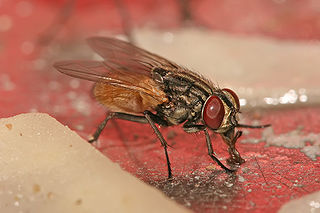
The Fanniidae are a small group of true flies largely confined to the Holarctic and temperate Neotropical realms; there are 11 Afrotropical species, 29 Oriental, and 14 Australasian.

Within the taxonomy of biology, the subfamily Muscinae includes two of the more familiar genera within the Muscidae family; Musca and Stomoxys.

Haematobia irritans, the horn fly, is a small fly. It was first described by Carl Linnaeus in his 1758 10th edition of Systema Naturae. It is of the genus Haematobia which is the European genus of bloodsucking flies. Haematobia irritans is a native of Europe but has been introduced to North America and is considered a potentially dangerous livestock pest.

Musca autumnalis, the face fly or autumn housefly, is a pest of cattle and horses.

Muscini is a Tribe of flies from the family Muscidae.

Helina reversio is a fly from the genus Helina, in the family Muscidae. It is a common and variable fly.

Morellia is a very large genus from the fly family Muscidae. Morellia are plumpish black flies, largely lacking eye hairs - sparse at most. they have a white dusting on the parafacialia and the scutum has 4 distinct longitudinal stripes.

Reinwardtiini is a Tribe of flies from the family Muscidae.

The subfamily Phaoniinae is within the Diptera family Muscidae. All species are in the tribe Phaoniini.

Graphomya maculata is a species of fly. It is widespread and common in most parts of Europe and also occurs in North Africa including the Canary Islands. The thorax bears the same black and white pattern in both sexes. Females also have a black and white abdomen, while the male has orange colouration on the abdomen as seen in the picture.

Phaonia angelicae is a species of fly which is widely distribution across the Palaearctic.

Phaonia pallida, the muscid fly or orange muscid fly, is a species of fly in the family Muscidae.

Hydrotaea dentipes is a fly from the family Muscidae. Its larvae have been found in the dung of rabbits, pigs, cows, horses, chickens and humans. It is found in the Palearctic.

Helina allotalla is a Palearctic fly from the family Muscidae.

Helina maculipennis is a long fly from the family Muscidae.

Hebecnema nigra is a fly from the family Muscidae. It is found in the Palearctic.

Hebecnema vespertina is a fly from the family Muscidae. It is found in the Palearctic.

Phaonia rufiventris is a fly from the family Muscidae. It is found in the Palearctic.

Hebecnema nigricolor is a fly from the family Muscidae. It is found in the Palearctic.

Lispe tentaculata is a fly from the family Muscidae. It is found in the Palearctic.



















